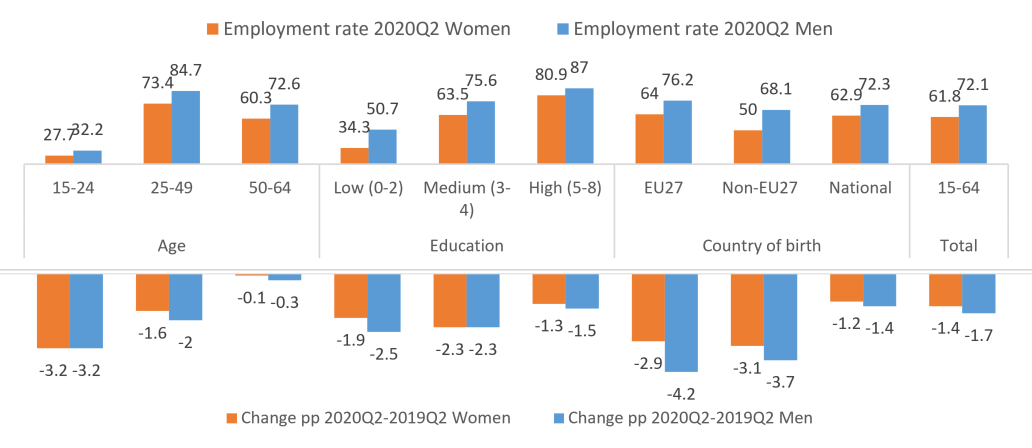
The coronavirus pandemic has led to an economic downturn. This has different consequences for women and men in the labour market.
Covid-19 led to the largest drop in working hours in the EU-27, since 2006, even greater than the one registered after the 2008 financial crisis. The fall in hours was greater for women than for men in almost all European countries.
Employment also dropped in all EU countries during the first wave of the pandemic. Overall, 2.2 million women lost their jobs, compared to 2.6 million men. As a percentage, the drop in employment, if comparing the second quarter of 2020 with 2019, was equal for men and women (-2.4%)
Despite rising employment rates in the summer, men still gained more than twice as many jobs as women. Time is starting to show that the economic impact of the pandemic is having longer lasting effects for women.
The scale of employment reductions is affecting women and men workers, born outside the EU in a big way. For women, their situation is especially concerning. Their employment rate dropped to 50 % and their chances of returning to pre-pandemic employment rates are low. Despite the large drop in employment for foreign born men, their employment rate stood at 68 % after the first Covid-19 lockdown period.

Source: elaboration of Eurostat LFSQ_ERGAED; LFSQ_ERGACOB data
In the EU-27, workers in the accommodation and food service sector, and those working in other services, such as entertainment and domestic work were most at risk of temporary layoffs or reduced hours. In the second quarter of 2020, the biggest loss of jobs in absolute numbers were in food service activities, retail trade, and accommodation. In food service activities in the EU-27, almost 1.3 million people lost their jobs, of which more than 700,000 were women.
Another group of people who are highly vulnerable to economic shocks are domestic workers. In the EU, the majority are women (95 %), mainly working part-time (69 %), with relatively low skills (56 %) and often from a migrant background (55 %) [1]. They are often employed as undeclared workers in the informal economy. They are also highly dependent on the employer and may have no or little knowledge of their rights and how to seek support.[2]
What policymakers need to know
- Fiscal measures adopted in the wake of the 2008 financial crisis had a disproportionately negative impact on women. This should be avoided in Covid-19 recovery measures.
- Each EU Member State must show how their national plan to access money from the EU’s Recovery and Resilience Facility (RRF) promotes gender equality. National plans should include:
- Evidence of gaps between women and men, with targets and indicators
- Proposed framework for sex-disaggregated data collection
- Figures for the amount of money that will be allocated to gender mainstreaming and specific measures to promote gender equality
- System to monitor and evaluate progress on gender equality.
- National gender equality bodies should work with the national structures responsible for Covid-19 recovery efforts to ensure gender-mainstreaming tools, such as gender impact assessments and gender budgeting, are used throughout the recovery.
For more information
Gender equality and the socio-economic consequences of the Covid-19 crisis